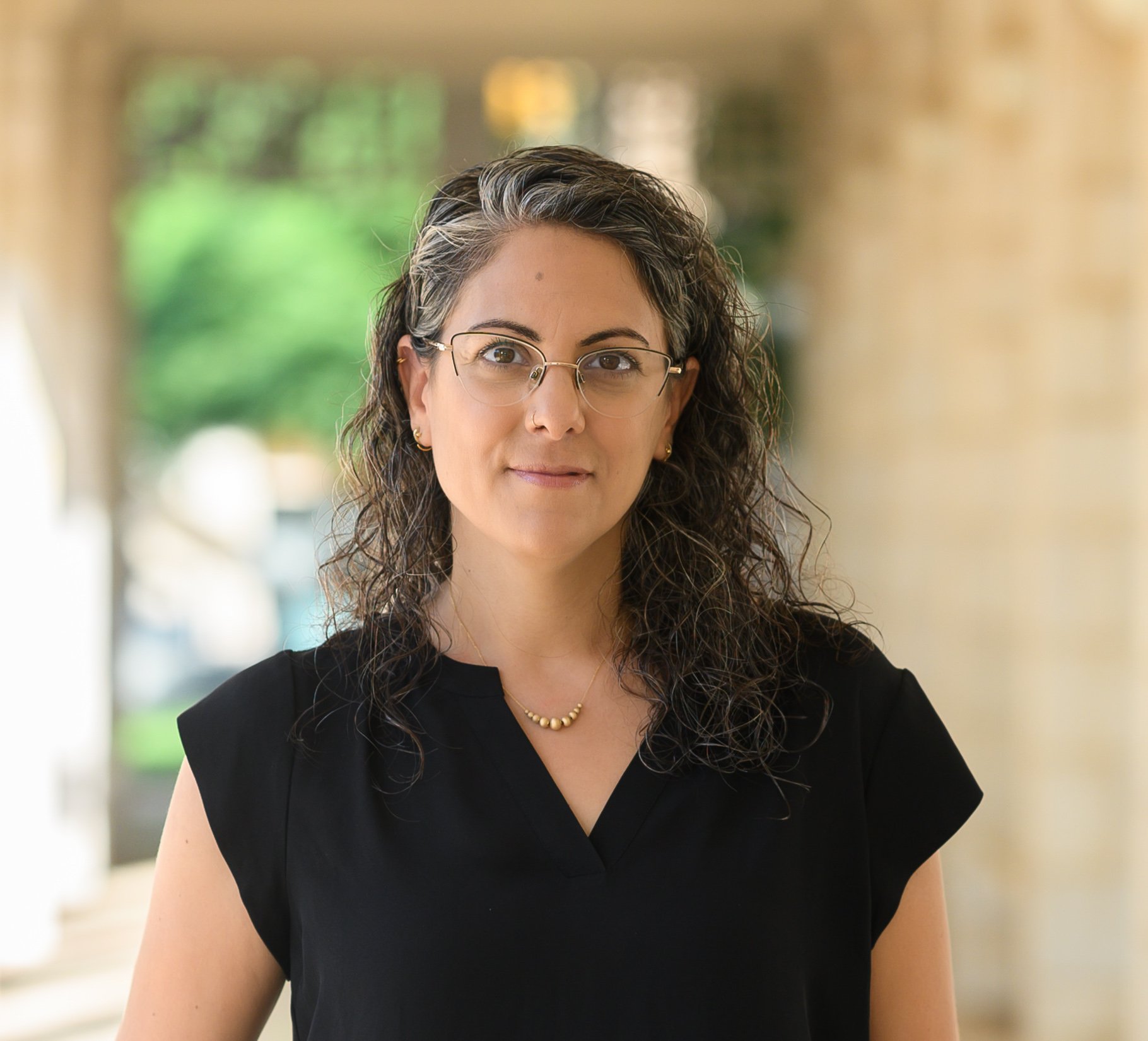| David Golomb | Computational Biology | 
| Dynamics of large neuronal networks. Models of the whisker somatosensoty cortex. Mechanical and neuronal model of whiskers, the motor plant and the motor brainstem.
| The Computational Neurophysics Lab | golomb@bgu.ac.il | Personal website | Faculty of Health Sciences, Building M6, Room 427 | |
| Tomer Hertz | Computational Biology; Infectious diseases | 
| The laboratory studies the immune response to vaccines, infectious diseases, biological drugs and autoimmune diseases. We use methods that generate large amounts of information about the immune response, and develop computational tools to analyse the results. The laboratory uses various technologies to map the immune response, including tools for broad characterization of antibodies, T cells and cytokines.
| The system immunology lab | thertz@bgu.ac.il | Personal website | The National Institute for Biotechnology in the Negev, Building 41, Room 105 | |
| Esti Yeger-Lotem | Computational Biology | 
| The Yeger-Lotem lab focuses on computational systems and network biology. Our main goals are to identify the cellular pathways that underlie human diseases and to decipher the remarkable robustness of cellular systems. To accomplish these goals we develop novel computational frameworks for deciphering large-scale biological measurements, and apply them to model systems to uncover their cellular circuitry and to diseases such as Parkinson, melanoma, viral infections and more.
| The Laboratory for Bioinformatics and Disease Research | estiyl@bgu.ac.il | | The National Institute for Biotechnology in the Negev, Building 41, Room 217 | |
| Ofir Cohen | Computational Biology | 
| In our laboratory we focus on challenges of cancer treatment while looking at the evolutionary phenomena and aim to develop computational tools and models to use the wealth of data to explain the processes of change and adaptation that cause cancer to "evade" treatment and return as a violent tumor.
| The laboratory for study of cancer drug resistance evolution using genomics and bioinformatics | ofircohen@post.bgu.ac.il | | Faculty of Health Sciences, Building M6, Room 225 | |
| Eitan Rubin | Computational Biology; Cancer and inflammatory disease | 
| We are working on the use of computational methods to improve the accuracy of cancer medicine. The laboratory is an important partner in an international consortium called WIN that promotes precision oncology. We use bioinformatics and machine learning to improve doctors' ability to predict which drug will help patients based on a tumor or blood biopsy.
| The Oncology Precision Research Laboratory | erubin@bgu.ac.il | | Faculty of Health Sciences, Building M6, Room 5 | |
| Itai Rousso | Infectious diseases | | The research in the laboratory aims to crack the mechanism of HIV virus replication with the help of advanced biophysical methods. The research focuses on a number of important stages in the life cycle of the virus: the assembly and release of the virus from the cell, the maturation and penetration of the virus into the target cell and the mechanism responsible for releasing the genetic load of the virus inside the cell. In order to study these processes, the laboratory uses an atomic force microscopy which allows discovery of the physical mechanisms behind these processes. The research combines methods of materials engineering, nanomechanics and biology.
| The laboratory for Nanomechanics of biological complexes | roussoi@bgu.ac.il | Personal website | Faculty of Health Sciences, Building M6, Room 1 | |
| Maoz Shamir | Computational Biology | 
| Prof. Shamir is a theoretical physicist by training and applies the theoretical tools from theoretical physics to brain research. The work in the laboratory is theoretical and requires a deep understanding of mathematics with priority for students with a background in physics, mathematics and engineering. The research in the laboratory deals with two main areas: 1. The study of the neural code. 2. Theory of neural learning.
| The laboratory for neurophysics and neural computation: learning, encoding and processing information in the brain | shmaoz@bgu.ac.il | | Faculty of Health Sciences, Building M6, Room 429 | |
| Ohad Birk | Genetic and Hormonal Disease |  | | The laboratory for Human Genomics and Medicine | obirk@bgu.ac.il | | The National Institute for Biotechnology in the Negev, Buliding 39, Room -1 | |
| David Ben-Menahem | Genetic and Hormonal Disease | 
| Mechanism of gonadotropin receptor activation. Design of recombinant bovine gonadotropin for potential application in animal agriculture. Using Drosophila melanogaster as a model to study potential geroprotective compounds. Molecular and biochemical pharmacology of the gonadotropins and their receptors. Post-translational modifications of recombinant proteins. Human and animal reproduction | The laboratory of molecular endocrinology | dbm@bgu.ac.il | | Faculty of Health Sciences, Buliding M6, Room 540 | |
| Hava Golan | Genetic and Hormonal Disease | 
| Our group is studying the interactions between epigenetic and environmental factor in the context of fetal brain development. The developing embryo in-utero is exposed to the maternal environment. Disturbance in the developmental plan during this critical period increase the risk for long lasting impairment in cognitive and emotional function later in life. Our interest focus in two potential factors: prenatal hypoxia and prenatal neuroleptic drug exposure. | The laboratory for the study of genetic defects as a cause of impaired brain development and psychiatric diseases | havag@bgu.ac.il | | Faculty of Health Sciences, Buliding M6, Room 440 | |
| Mahmoud Huleihel | Genetic and Hormonal Disease | 
| Research in the laboratory focuses on preservation of male fertility. We are engaged in development of unique technologies for growing testicular germ cells (spermatogonia cells) in culture and in vitro in order to produce mature sperm cells. We are also looking for genetic and environmental factors that are involved in male fertility impairment. | The male fertilify laboratory | mahmoudh@bgu.ac.il | | Marcus Campus, Buliding 39, Room 316 | |
| Ariel Tarasiuk | Genetic and Hormonal Disease | 
| The laboratory deals with the mechanisms involved in sleep disorders, energy balance and growth processes after removal of narrowing of the upper airways. The laboratory focuses on understanding the molecular mechanisms associated with sleep breathing disorders and their effect on the growth hormone axis and the control of eating. | The sleep and respiratory physiology laboratory | tarasiuk@bgu.ac.il | | Soroka Medical Center, Floor 6, Room 627 | |
| Dan Levy | Genetic and Hormonal Disease |  | The overall goal of the study is based on the hypothesis that dynamic methylation of histone and non-histone proteins plays an important role in the epigenetic regulation of cellular signaling pathways that have a substantial impact on human health. We use biochemical and cellular approaches together with novel genomic and proteomic tools to unravel the molecular mechanisms by which lysine methylation regulates oncogenic and cellular differentiation processes. We aim to identify novel methylation events on histone and non-histone proteins, define the molecular mechanisms by which these methyl marks are generated and translate this knowledge into the development of future therapeutic applications. | The Laboratory for Epigenetics and Protein Methylation | ledan@post.bgu.ac.il | Personal website | The National Institute for Biotechnology in the Negev, Buliding 41, Room 102 | |
| Ruti Parvari | Genetic and Hormonal Disease | 
| In the laboratory, we try to identify and understand the mechanism of action of mutations that cause genetic diseases in patients. The identification enables an accurate diagnosis of diseases and the possibility of a valid prediction for the birth of healthy children. The identification of the genes in which the mutations occur and the study of their mechanism of action allow a better understanding of the pathogenesis and the adaptation of a better treatment. | The human genetics laboratory | ruthi@bgu.ac.il | | The National Institute for Biotechnology in the Negev, Buliding 41, Room 202 | |
| Dan Bar Yaacov | Infectious diseases | 
| The research in the laboratory focuses on a process called mRNA editing, leading to the translation of proteins with new activity. Our work focuses on model bacteria in the laboratory (for example E. coli) and bacteria that cause diseases in humans. | The laboratory for the study of mRNA editing in bacteria | danbary@bgu.ac.il | | Marcus Campus, Building 39, Room 113 | |
| Claytus Davis | Infectious diseases | 
| Pregnancy presents an immunological challenge: on the one hand, the fetus and the mother need protection from pathogens and on the other hand, they must not react to each other's presence. In our laboratory we study the innate immune system in the fetus, which turns out to be much more sensitive than in the adult. We are working to understand the consequences of fetal immune response to viral infection and communication from the fetus to the mother. | The laboratory for the study of the innate fetal immune system | clay@bgu.ac.il | | Soroka Medical Center, Pathology Building, Room 351 | |
| Mahmoud Huleihel | Infectious diseases | 
| Research in the laboratory focuses on search for natural and synthetic substances with antiviral activity. The study of various molecular aspects related to the retrovirus HTLV-1 including its possible involvement in breast cancer. Diagnosis and identification of bacterial sensitivity to antibiotics directly from the patient's sample. | The laboratory for infectious diseases - viruses | | | Soroka Medical Center, Room 677 | |
| Ran Taube | Infectious diseases |  | The research in the laboratory focuses on understanding the molecular processes that regulate the transcription and reproduction of the HIV virus. Identification of cellular proteins involved in the latent state of the virus, which is a major obstacle to curing disease. | The laboratory for research of the control of replication and reproduction of the HIV virus | rantaube@bgu.ac.il | | Marcus Campus, Building 39, Room 326 | |
| Neta Sal-Man | Infectious diseases |  | The research in the laboratory focuses on a deeper understanding of how certain bacteria live "peacefully" inside our bodies while others cause disease (pathogens). In the lab we are working on a large protein complex that creates a bacterial syringe that allows toxins to be injected into the host cell. A thorough understanding of this protein complex will allow us to develop new antibiotic drugs against disease-causing bacteria. In addition, we are working on an innovative development with the help of which we can use the "bacterial syringe" to introduce different substances into cells. | The laboratory for microbiology, infectious diseases and bacteriology | salmanne@bgu.ac.il | Personal website | Faculty of Health Sciences, Building M6, Room 126 | |
| Ehud Ohana | Metabolic and Cardiovascular disease | 
| Our major interest is in the mechanism and function of transmembrane proteins mediating the transport of electrolytes and metabolic products as it relates to disease states. Our research focuses on Slc26 transporters since very little was known about members of this family, however, a rapidly growing number of human diseases that are linked to disruption of genes encoding Slc26 transporters underscores their physiological importance. To date, our study of the Slc26 proteins revealed very unique electrophysiological behaviors that cannot be explained based on our knowledge of current structural models of cation transporters and, hence, the establishment of new models was required. Using bioinformatics tools and various experimental techniques we have established a novel structure-function and protein-protein interaction models of Slc26 transporters utilizing computer modeling and experimental results in-vitro and in-vivo. Our study of biophysical, biochemical and functional properties of Slc26 mediated ion transport had a major impact on our understanding of Cl-, pH and carboxylic acid homeostasis mechanisms and metabolism under physiological and pathophysiological conditions. | The laboratory of cell and tissue metabolic pathways and communication | ohanaeh@bgu.ac.il | | Soroka Medical Center, Building 12, Room 473 | |
| Elie Beit-Yannai | Metabolic and Cardiovascular disease; Drug development | 
| ree Radicals mediated damage, Glaucoma, Aged Macular Degeneration. The role of oxidative stress in the pathophysiology of optic nerve degeneration diseases. Cyclic Voltammetry as a tool for evaluation of reducing capacity in biological systems | The laboratory for the study of exosomes and their roles in the visual system | bye@bgu.ac.il | | Faculty of Health Sciences, Building M6, Room 522 | |
| Amos Douvdevani | Metabolic and Cardiovascular disease |  | Development of novel peritoneal dialysis compounds. The role of cfDNA in patients blood. | The nephrology research laboratory | rudich@bgu.ac.il | Personal website | Soroka Medical Center, Building 12, Room 459 | |
| Ariel Tarasiuk | Metabolic and Cardiovascular disease | 
| The laboratory deals with the mechanisms involved in sleep disorders, energy balance and growth processes after removal of narrowing of the upper airways. The laboratory focuses on understanding the molecular mechanisms associated with sleep breathing disorders and their effect on the growth hormone axis and the control of eating. | The sleep and respiratory physiology laboratory | tarasiuk@bgu.ac.il | | Soroka Medical Center, Floor 6, Room 627 | |
| Noam Levaot | Metabolic and Cardiovascular disease | 
| The research in the laboratory focuses on the mechanisms of action of skeletal cells in a comprehensive approach, which includes understanding biochemical and molecular processes from the cell level to construction of complex genetic models based on genomic editing using the CRISPR method in animals. We aim to understand what affects the quality of the skeleton. | The laboratoy for skeletal biology and medicine | nlevaot@gmail.com | | Faculty of Health Sciences, Building M6, Room 318 | |
| Yoram Etzion | Metabolic and Cardiovascular disease |  | The laboratory focuses on cardiac electrophysiology by using unique models to examine the effect of cardiac pacing and the induction of cardiac arrhythmias in rodents. The models allow the examination of innovative pharmacological treatments to prevent atrial fibrillation. In addition, the laboratory investigates cardiac genetics, and characterizes how genetic mutations cause damage to the heart's function (in collaboration with Prof. Ruthi Parvari). The laboratory also examines the topic of regenerative medicine used for innovative treatments for myocardial infarction (in collaboration with Prof. Samder Cohen and Prof. Niv Papo). | The Cardiac Physiology laboratory | tzion@bgu.ac.il | | Marcus Campus, Building 42, Room 316 | |
| Assaf Rudich | Metabolic and Cardiovascular disease | 
| The research in the laboratory proceeds along three parallel paths: 1. The study of basic biochemical processes of fat cells, focusing on the mechanism of glucose uptake into the cell, transmission of intracellular signals by insulin, oxidative stress and fat breakdown process. 2. The study of the applicable changes in subcutaneous and abdominal fat tissues in the phenomenon of the metabolic syndrome. 3. Epidemiological studies related to obesity and diabetes. | The laboratory of biochemistry of diabetes and obesity | rudich@bgu.ac.il | Personal website | The National Institute for Biotechnology in the Negev, Building 41, Room 136 | |
| Yael Segev | Metabolic and Cardiovascular disease | 
| The main project in the laboratory deals with the anemia associated with chronic kidney disease (CKD). Clinical observations link the increased inflammatory state of CKD to the various complications of the disease, including anemia. A central pathway in the inflammatory response in CKD appears to be related to the activation of the innate immune system. We are investigating the mediators involved in the process and in addition we are working on finding an intervention that will reduce the inflammatory response and lead to an improvement in kidney functions and anemia indicators. | The laboratory for chronic kidney disease (CKD) and low-grade inflammatory processes | yaelse@bgu.ac.il | | Soroka Medical Center, Building 22 , Room 671 | |
| Abed Azab | Neuroscience and neuordegenerative disease; Drug development | 
| The laboratory is engaged in researching the involvement of inflammation in the pathophysiological mechanism and in the treatment of mental illnesses and ischemic stroke. We try to better understand the mechanism of action of drugs already in clinical use, and investigate the effectiveness and safety of new treatment methods. Various animal models (rats) of mental illness and stroke are used in the laboratory. Also, the laboratory maintains a research relationship with researchers and clinicians to test the effectiveness of modern treatment methods among patients with psychiatric disorders. | The Psychopharmacology Laboratory | azab@bgu.ac.il | | Soroka Medical Center, Building 22, Room 648 | |
| Rony Azouz | Neuroscience and neuordegenerative disease | 
| Rodent whisker hairs belong to the category of sensory hairs. In the laboratory we test the neural mechanisms underlying this sensory modality. We mainly focus on the ability of rodents to distinguish the degree of roughness of different textures. This topic allows us to investigate the neuronal basis underlying behavior from the level of sensory stimulation through transduction in mechanoreceptors, to neuronal activity in the cerebral cortex, from the layer of the single neuron to the interaction in a population of neurons. | The laboratory for physiology of sensory perception | razouz@bgu.ac.il | | Faculty of Health Sciences, Building M6, Room 447 | |
| Claude Brodski | Neuroscience and neuordegenerative disease | | The overall aim of our lab is to better understand the molecular mechanisms controlling the development, maintenance and dysfunction of dopaminergic neurons and improve therapies for dopamine-associated disorders. | The laboratory of developmental neurobiology | | | | |
| Hagit Cohen | Neuroscience and neuordegenerative disease | 
| The research in the laboratory deals with animal models for stress and anxiety reactions and psychopathologies such as the post-traumatic syndrome and depression, with the aim of studying the neurobiological mechanism involved in these syndromes. | The stress and anxiety research laboratory | hagitc@bgu.ac.il | | The Mental Health Center, Pavilion 7 | |
| Stas (Stanislav) Engel | Neuroscience and neuordegenerative disease | 
| Misfolded SOD1 as a target in Amyotrophic Lateral Sclerosis (ALS) drug discovery. Structural basis of GPCR signal transduction. Protein/protein and protein/small-molecule interactions. Targeting protein/protein interfaces by drugs. Identification of biologically active compounds using in vitro selection methods. Computer-aided drug discovery. | The laboratory for the study of the molecular mechanism of muscular dystrophy disease, ALS | engels@bgu.ac.il | Engel's lab | Marcus Campus, Building 39, Room 322 | |
| Ilya Fleidervish | Neuroscience and neuordegenerative disease | | | The Neurophysiology laboraatory | | | | |
| Sigal Fleisher-Berkovich | Neuroscience and neuordegenerative disease | 
| My research focuses on the mechanisms by which inflammation is modulated, its effects on neuroglia and the manner in which this impacts on neurodegenerative diseases. The laboratory focuses on two main topics: the first of which is the regulation of brain inflammation by neuropeptides and implications for Alzheimer's disease. The second deals with regulation of inflammation in multiple sclerosis by cannabinoids and unique cannabis strains (in collaboration with Prof. Shimon Ben Shabat). | The laboratory of neuro-inflammatory disease | Fleisher@bgu.ac.il | | Faculty of Health Sciences, Building M6, Room 530 | |
| Alon Friedman | Neuroscience and neuordegenerative disease | 
| The research in the laboratory deals with the development of diseases of the central nervous system, such as epilepsy, stroke and neurodegenerative diseases. The research is multidisciplinary and combines basic and clinical research, with the aim of developing innovative tools for the prevention and treatment of brain diseases. | The Blood-brain barrier laboratory | alonf@bgu.ac.il | Personal website | Soroka Medical Center, Building 22, Room 648 | |
| Daniel Gitler | Neuroscience and neuordegenerative disease |  | The Gitler lab studies the structure and function of the presynaptic terminal of the synapse, with an emphasis on the proteins which control the clustering of synaptic vesicles and their readiness for release. | The laboratory of synaptic communication between nerve cells in the brain | gitler@bgu.ac.il | | Faculty of Health Sciences, Building M6, Room 438A | |
| Michal Hershfinkel | Neuroscience and neuordegenerative disease; Cancer and inflammatory disease | 
| Zinc is important in growth and development as well as in the function of most systems. In the laboratory, we study the role of this ion at the cellular level, and the signalling pathways it activates. We specifically focus on a zinc receptor, ZnR/GPR39, which activates cellular signals related to cell division and the activation of cellular transport systems. We dissect the role of ZnR/GPR39 in the digestive system and salivary glands as well as the brain, and study its role in diseases such as colitis, dry mouth, breast cancer, glioma and epilepsy. | The zinc biology laboratory | hmichal@bgu.ac.il | Personal website | Faculty of Health Sciences, Building M6, Room 338 | |
| Adrian Israelson | Neuroscience and neuordegenerative disease | 
| The laboratory examines factors related to the development and progression of degenerative brain diseases with an emphasis on muscular dystrophy, ALS. The laboratory combines various methods including biochemistry, molecular biology, genetics, and gene therapy. The laboratory works with various models that include cell cultures, human cells and tissues and in order to better understand the mechanisms of the disease and to propose new strategies for treatment. | The laboratory for the study of ALS and degenerative brain diseases | adriani@bgu.ac.il | Personal website | Faculty of Health Sciences, Building M6, Room 432 | |
| Shira Knafo | Neuroscience and neuordegenerative disease |  | We seek to identify the molecular and synaptic mechanisms underlying learning and memory, cognitive malfunction, and cognitive enhancement. This knowledge is further translated to developing novel approaches for memory enhancement. | The laboratory for molecular cognition and the biological basis of learning and memory | shirak@post.bgu.ac.il | Personal website | The National Institute for Biotechnology in the Negev, Building 41, Room 229 | |
| Alon Monsonego | Neuroscience and neuordegenerative disease | 
| Both the brain and the immune system begin their journey with a learning process, directly linked to the environmental settings, to ultimately generate memory and execute effector functions; many of these functions control body homeostasis and are co-regulated throughout life. The implication of immune regulation in many disorders is thus a fast-emerging field as it holds a great promise in disease prevention, early diagnosis, and treatment. | The Neuroimmunology laboratory | alonmon@bgu.ac.il | Personal website | Marcus Campus, Building 39, Room 3 | |
| Esther Priel | Neuroscience and neuordegenerative disease | 
| We developed new substances that increase telomerase, which serve as an excellent tool for us today to investigate the involvement of the enzyme telomerase in several main areas: in neurodegenerative diseases such as Alzheimer's, in fertility and in the heart. | The laboratory for the development of telomerase-based drugs for neurodegenerative diseases, cardiac drugs and to improve fertility | priel@bgu.ac.il | | Faculty of Health Sciences, Building M6, Room 230 | |
| Israel Sekler | Neuroscience and neuordegenerative disease |  | The laboratory deals with the development of methods to control the metabolism in the cell and the body using light, and molecular research of calcium carriers in the mitochondria, identifying the role of calcium carriers in the mitochondria in diabetes, stroke, Parkinson's and Alzheimer's. In addition, we deal with molecular intervention in the activity of calcium carriers in the mitochondria for the purpose of curing these diseases and control of metabolism in the mitochondria and in the body. | The Molecular Research of Calcium Metabolism and Signaling and Their Significance in Stroke and Neurodegenerative Diseases. | sekler@bgu.ac.il | | Faculty of Health Sciences, Building M6, Room 441 | |
| Gad Vatine | Neuroscience and neuordegenerative disease; Stem Cell Research | 
| Our research aims to understand the mechanisms that underlie neurological disorders and develop personalized therapeutic approaches for patients. We use patient-specific stem cells to recreate diseases in a dish. Our main interest is to study the role of the blood brain barrier (BBB) in neurological disorders. | The laboratory for research of rare neurological diseases and the blood-brain barrier | vatineg@bgu.ac.il | Personal website | Marcus Campus, Building 42, Room 326 | |
| Alex Braiman | Cancer and inflammatory disease | 
| Tracing differences between the control processes in cancer cells compared to normal cells. One of the main goals of the laboratory is to find a solution for the resistance of the cancerous tumors to treatment by focusing on the cancer stem cells.
| The laboratory for cancer cell biology and the immune system | braiman@bgu.ac.il | | Faculty of Health Sciences, Building M6, Room 220 | |
| Michael Danilenko | Cancer and inflammatory disease |  | We investigate the molecular mechanisms of anticancer activity and therapeutic potential of combinations between natural and synthetic compounds in leukemia models in cell cultures and laboratory animals. The research focuses primarily on acute myeloid leukemia (AML) with the aim of identifying and characterizing the combinations that demonstrate strong synergistic anticancer effects at low, non-toxic doses of each compound. | The laboratory for leukemia treatment research | misha@bgu.ac.il | | Soroka Medical Center, Building 12, Room 6032 | |
| Ayelet David | Cancer and inflammatory disease; Drug development | 
| We develop biologically compatible therapeutic polymers and nanomedicines that can target specific cells and tissues in the body. Our primary aim is to deliver drugs to specific sites in order to treat cancer, cardiovascular diseases, liver diseases, and other life-threatening illnesses. | The laboratory for development of biomedical polymers and nanomedicines for treatment of cancer and inflammation | ayeletda@bgu.ac.il | Personal website | Faculty of Health Sciences, Building M6, Room 538 | |
| Moshe Elkabets | Cancer and inflammatory disease |  | Mechanisms of resistance to targeted therapies and investigate novel therapeutic strategies in head and neck cancer. Develop unique cancer models in mice to study the role of the tumor microenvironment in response to therapy.Study the interface between immunotherapy and cancer genomics. | The laboratory of mechanisms of resistance to anticancer drugs | moshee@bgu.ac.il | Personal website | Faculty of Health Sciences, Building M6, Room 223 | |
| Daniel Fishman | Cancer and inflammatory disease | | | The cancer research laboratory | | | | |
| Jacob Gopas | Cancer and inflammatory disease; Stem Cell Research | 
| Isolation and characterization of natural anti-cancer, anti-inflammatory and antiviral products from plants and marine bacteria. | The laboratory for the study of inflammatory mechanisms against cancer cells, damage to heart cells and pathogens | Jacob@bgu.ac.il | | Faculty of Health Sciences, Building M6, Room 228 | |
| Etta Livneh | Cancer and inflammatory disease |  | The research group is engaged in the study of cellular mechanisms that are important for the development of cancer, especially those related to resistance and survival of cancer cells following DNA damage, such as following stress conditions and chemotherapy. The knowledge gained in our research is now being applied to development of a drug for breast cancer and other tumors. | The laboratory for cancer research and cell signaling | etta@bgu.ac.il | | Faculty of Health Sciences, Building M6, Room 236 | |
| Angel Porgador | Cancer and inflammatory disease |  | We are interested in the innate immune system which acts as the first line of defense against infections. The research is broad, frequently taking inspiration from the immune system into another setting. | The laboratory for cancer immunotherapy and diagnostics of treatments (personalized cancer medicine). | angel@bgu.ac.il | | The National Institute for Biotechnology in the Negev, Building 41, Room 127 | |
| Elena Voronov | Cancer and inflammatory disease |  | We focus on studying the effects of IL-1 on the development and progression of tumors in mice wlacking various molecules of IL-1. Evaluation of the mechanisms involved in cancer progression in ex vivo systems. Development of new therapeutic agents against cancer based on the biology of molecules of the IL-1 family. Studying the effects of IL-1 molecules in acute and chronic inflammation. | The Laboratory for the study of the Role of Interleukin-1 Molecules in Homeostasis and Pathological Conditions | elena@bgu.ac.il | | Faculty of Health Sciences, Building M6, Room 136 | |
| Shimon Ben-Shabat | Drug development | 
| Bioorganic studies of natural products: isolation, structural and mechanistic studies of endogenous compounds. Medicinal Chemistry – structure activity relationship (SAR). Drug design - delivery and targeting (Prodrugs). Isolation, structural characterization and synthesis of biomedically important bioactive compounds from plants sources for drug discovery purpose. | The laboratory for bioorganic and medicinal chemistry | sbs@bgu.ac.il | | Faculty of Health Sciences, Building M6, Room 529 | |
| Arik Dahan | Drug development | | | | | | | |
| David Stepensky | Drug development | 
| We study the processes that drugs go through in the body and determine their effectiveness and safety. Each drug involves a unique set of biopharmaceutical, pharmacokinetic and pharmacodynamic processes, which may vary between patients and require individual adjustment. We study the dose-concentration-activity relationships of drugs in laboratory animals and patients, and use mathematical/statistical analysis (PK-PD modeling) to quantitatively characterize these relationships. | The laboratory for the study of pharmacokinetics, pharmacodynamics, and drug administration systems | davidst@bgu.ac.il | | Faculty of Health Sciences, Building M6, Room 529 | |
| Idan Cohen | Stem Cell Research | 
| The research in the laboratory focuses on epigenetic control mechanisms that govern the fate of skin epithelial cells during development as well as the involvement of epigenetic regulators and transcription factors in the development of skin diseases and skin cancer. | The laboratory for the study of epigenetic control of transcription in differentiation of epidermal stem cells | idancoh@bgu.ac.il | | Marcus Campus, Building 39, Room 317 | |
| Roi Gazit | Stem Cell Research |  | Stem Cells generate new cells needed in our bodies for healthy life, and further regenerate damaged tissues upon insults. How adult stem cells are able to self-renew and sustain multipotency is largely unknown. Now, study of hematopoietic stem cells (HSCs) aims to discover basic biological mechanisms that enable their amazing function – as these cells already saves thousands of lives by bone marrow transplant. Revealing HSC’s regulation will also enable us to control the source of the immune system. | The laboratory for stem cell the blood and immune systems | gazitroi@post.bgu.ac.il | Personal website | The National Institute for Biotechnology in the Negev, Building 41, Room 107 | |
| Mahmoud Huleihel | Stem Cell Research | 
| Research in the laboratory focuses on preservation of male fertility. We are engaged in development of unique technologies for growing testicular germ cells (spermatogonia cells) in culture and in vitro in order to produce mature sperm cells. We are also looking for genetic and environmental factors that are involved in male fertility impairment. | The male fertilify laboratory | mahmoudh@bgu.ac.il | | Marcus Campus, Building 39, Room 316 | |
| Benyamin Rosental | Stem Cell Research | 
| The laboratory focuses on transplanting stem cells in unique animal models. Among the projects in the laboratory is a project of manipulating the immune system in transplantation of stem cells of the blood system, using a unique model with a "natural" transplantation ability. Another project deals with understanding the "breaking point" of the immune system between allowing regeneration (rebuilding the tissue) and a pro-inflammatory response which leads to the destruction of the tissue. Finally, we are engaged in a unique project that uses the knowledge accumulated in our laboratory, in order to isolate and implant stem cells in corals. | The Laboratory for Comparative Immunology and Stem Cell Transplantation | rosentab@post.bgu.ac.il | Personal website | Marcus Campus, Building 42, Room 337 | |
| Rachel Levy | Cancer and inflammatory disease; Drug development | 
| Our research studies the inflammatory process that has a major role in the development of various diseases. We focus mainly on cytosolic phospholipase A2a which plays a critical role in the development of inflammation. We engineered a specific antisense drug against this enzyme to develop an efficient drug for the treatment of inflammation. After successfully studying different mouse model diseases we are currently focusing on neurodegenerative diseases and especially on - Amyotrophic Lateral Sclerosis (ALS) in a mouse model. In addition, we are studying the role of carotenoids and other Phyto-ingredients in inhibiting inflammation.
| The cPLA2a and inflammation laboratory | ral@bgu.ac.il | | Soroka Medical Center, Building 12, Room 469 | |
| Yaakov Moran-Gilad | Infectious diseases |  | The research in the laboratory focuses on development and application of advanced methods, which combine classical microbiology, molecular microbiology and genomics. We combine approaches from wet laboratory, computational biology / bioinformatics and public health in order to trace the epidemiology of infectious diseases, such as the spread of epidemics (including corona), antibiotic-resistant bacteria, and diseases transmitted through water and food in order to develop policies to prevent morbidity and maintain public health. The laboratory deals with a large variety of pathogens and diseases and maintains extensive collaborations with researchers in Israel and abroad.
| The Laboratory for Genomics Research of Pathogens | giladko@post.bgu.ac.il | | Marcus Campus, Building 39, Room 116 | |
| Tomer Cooks | Cancer and inflammatory disease | | The CooksLab focuses on various aspects of the tumor microenvironment, particularly cell-to-cell communication via extracellular vesicles. Amongst many hallmarks of cancer, an ‘in-depth’ spotlight is dedicated to mutations in the tumor suppressor TP53 gene and the plethora of interactions this molecular event facilitates. These include cancer cells communicating with their surroundings (including the stroma, the immune compartment and the microbiome). In addition, the CooksLab constantly strives to use innovative translational approaches for the benefit of cancer patients. Therefore, we combine the knowledge and toolset of the lab with the pioneering Diffusing Alpha-emitters Radiation Therapy (DaRT), enabling us to provide insights about molecular traits with fundamental relevance to clinical decision-making. | Exome Biology in Cancer | cooks@bgu.ac.il | Personal Website | Faculty of Health Sciences, Building M6, Room 129 | |
| Danielle Karo-Atar | Infectious diseases; Stem Cell Research | 
| We study the immune response to helminths (parasitic worms). We are combining stem cell research with immunology, in the settings of helminth infections, to understand the interaction between helminths and the host intestinal epithelium. We are applying cutting-edge 3D organoid cultures, imaging, transcriptomics and in vivo genetic model approaches to explore whether helminths can be used to promote intestinal health.
| The laboratory for immuno-parasitology and the study of stem cell regulation by enteric parasites | atardani@bgu.ac.il | Personal Website | Faculty of Health Sciences, Building M6, 527 | |
